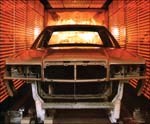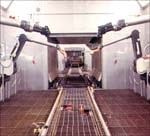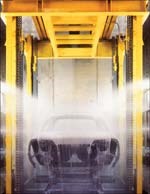Life in the Fast Lane
DuPont's Automotive Application Facility is designed to help automotive and general industrial customers meet the day-to-day challenges without having to shut down production lines...
Harvey Maxwell’s job requires him to be a chameleon of sorts.
As the Research Supervisor of the DuPont Automotive Application Facility (Troy, MI), Maxwell and his team are charged with the task of providing support and training to the company’s customers in the automotive and general industrial arenas. This means that because of the vast differences in coatings and application equipment found in various automotive plants and job shops around the country, Maxwell might be required to be an expert on powder coating on one day, e-coat the next and liquid spray the day after that.
Much like its 15-person support staff, the facility—which opened in 1987 and launched its e-coat system a year later— serves a variety of different functions.
Chief among these is its role as a testing ground for new coatings for compatibility with the existing application technologies used by automakers. To that end, the staff conducts programs to establish optimum product and process parameters under simulated assembly plant production conditions. This allows automakers to test and refine their paint operations under realistic conditions before actual vehicle production begins or without interrupting assembly lines that are already in production.
“We need to make sure that we’re not going to have a detrimental effect on our customers’ capacity to generate their vehicles,” says Maxwell. “By simulating the conditions found at a customer’s facility and minimizing the variables in the testing process, we can be assured that the coating is going to be a good fit from process and quality standpoints.”
The facility also functions as a means of validating various coating application technologies. “We can be an objective third party to assure customers that their equipment—or equipment that they are looking to purchase—is going to work with the coatings,” says Maxwell.
Finally, the facility serves as a training center for technicians new to the industry, or those working at facilities where coating technologies are being updated. “If there is a process change, many times the customer may have an equipment understanding, but they don’t understand how the equipment interfaces with our coatings,” says Maxwell. “Our goal is to help them understand where the potential land mines lie.” Since it was opened, thousands of coating technicians have visited the facility for training.
A Variety of Coating Processes
The centerpiece of DuPont’s facility is its electrocoat system, which features a pair of identical e-coat tanks. Situated side-by-side, the baths enable the DuPont staff to perform comparisons and evaluations of new and existing products. The tanks are each 18,000 gal, making them large enough to accommodate a large SUV. Using the system’s quality control system, technicians can monitor vehicle dwell time in the e-coat tanks, as well as bath temperature, solids content, circulation and voltage.
Another highlight of the e-coat system is the conveyor, which can be programmed to mimic angles of entry and exit that would be found in an automotive assembly plant. Large enough to accommodate a full-size car or mini-van, the conveyor also allows DuPont to perform dragout studies on prototype vehicles. In addition to the automotive tanks, the facility features three smaller e-coat systems (50, 100 and 300 gallon) for industrial components.
Complementing the electrocoat system is a 60-ft stainless downdraft booth that features a side/overhead reciprocating spray station, an electrostatic oscillating/stationary turbo-bell station and a hand spray station. A six-line independent circulation system makes a complete loop around the booth.
In the facility’s robotic spray zone, four computer-controlled robots—mounted on X-rails—work in pairs to simulate a modular painting facility. The center also features a manual spray booth for working with various application equipment/systems and an off-line finesse booth for handwork preparation, detailing and defect removal.
Heating and cooling technologies at the facility include a two-stage gas-fired convection oven, a high velocity flash oven and a 20-ft long cooling tunnel for providing rapid cool down of various vehicle designs.
The application facility also features a color styling studio (where automotive color trends are identified), a research and development lab, a refinish training center for the development of aftermarket repair products and procedures, an advanced composites development facility and a computer-aided engineering center.
As part of an effort to ensure that it stays current with the ongoing developments in the industry, DuPont says it has invested more than $5 million in the facility in the last four years. “It's important for us to be able to remain a step or two ahead of our customers,” says Maxwell. “By the time they come to us with a question or problem relating to a new technology, we should already know the answer.”
Related Content
Top Shop Leader Focuses on Its People as Key to Success
Twin Cities job shop, Avtec, was named a Top Shop for the third time in 2022, due in no small part to its commitment not only to the work it produces but to those who produce it — its employees.
Read MoreTTX’s Automated Conveyor Carrier System Offers Wireless, Flexible Operation
ACC system designed for reliable, consistent point-to-point movement of everything from small to heavy parts.
Read MoreCoatings Plant Evolves with Market Trends
Expanding its focus from exclusively serving the RV industry, one of this company’s stand-alone coatings plant has successfully extended its services to additional markets.
Read MoreFinishing Systems Provider Celebrates 150 Years, Looks to Future
From humble beginnings as an Indiana-based tin shop, Koch Finishing Systems has evolved into one of the most trusted finishing equipment providers in the industry.
Read MoreRead Next
A ‘Clean’ Agenda Offers Unique Presentations in Chicago
The 2024 Parts Cleaning Conference, co-located with the International Manufacturing Technology Show, includes presentations by several speakers who are new to the conference and topics that have not been covered in past editions of this event.
Read MoreEpisode 45: An Interview with Chandler Mancuso, MacDermid Envio Solutions
Chandler Mancuso, technical director with MacDermid Envio discusses updating your wastewater treatment system and implementing materials recycling solutions to increase efficiencies, control costs and reduce environmental impact.
Read MoreEducation Bringing Cleaning to Machining
Debuting new speakers and cleaning technology content during this half-day workshop co-located with IMTS 2024.
Read More

























